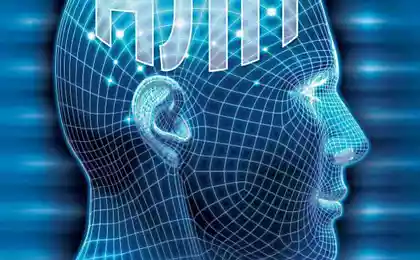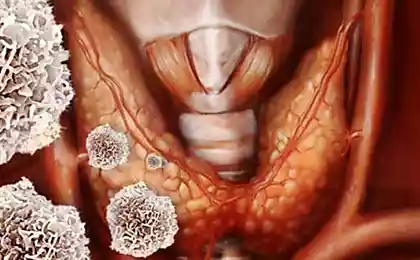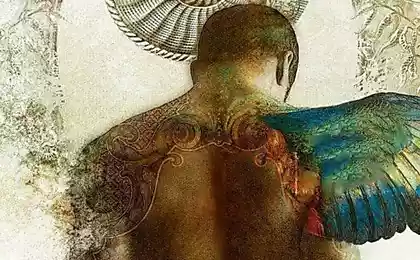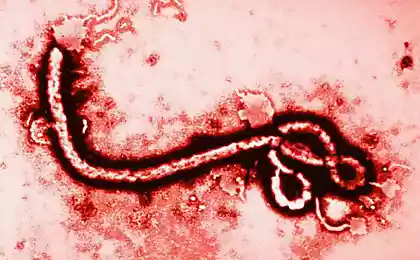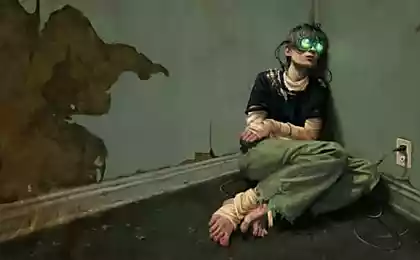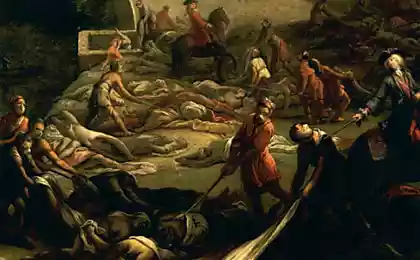659
Psychosomatics: a viral disease — the lack of meaning of life
Virus — infectious agent that can multiply only in living cells of human, animal, plants or bacteria.
The basis for the development of the virus in the human body is energy of a certain quality, of a destructive nature produced them as a result of internal problems with self-esteem, dignity, sense of its existence.

The emergence of viruses in the body signals the person about the lack of joy in life, the collapse of any illusions and the experience of sorrow, of bitterness about it. Such as vibrations (energy) that sets the stage for virus infection, for example, sexually transmitted, can be created in both the current life and to be inherited in the form of genetic programs (stress, vibration), carrying the message of the ancestors of understated meaning of life, by which they were guided, humiliation that they experienced, the loss of the Divine, nedostupnosti, frustration and anguish for the lost.
Transferred program can "sleep" and be activated in a situation when the person will experience profound disappointment, low self-esteem, denial of dignity, loss existing before the meaning of life. The position of the person in these experiences is a certain quality of energy supported the current situation and genetic programs that create better conditions for Contracting the virus.
First is virus infection due to favorable conditions for its life, and then the virus, as the simplest creature wants to live, begins to support these conditions for its existence — the energy-informational background of helplessness, dejection, humiliation of man. It is a vicious circle supported on two sides: man is a thinking and feeling a certain way and virus, and the infected breeding-enabled energy in the body.
The virus integrates into the cell and become part of a person.
To kill the virus, to kill the part of man. Medicine cures the virus preparations and the virus feeds off energy, man.
A person swallows a pill, and think and feel humiliated, confused, pointless, not perstat. The antiviral drug has an effect on anything but thinking.
To kill the virus, it is necessary to heal a person from the causes that creates vibrations favourable to the life of the virus.
If people do not change their attitude towards themselves and the world, will not find meaning, healing his self-esteem, depression, sadness, abandonment, the virus will live and prosper.

At a young age, for example, herpes simplex virus manifests cold on the lips. Man drives away your thoughts and attitudes towards themselves and the world with Hyper-activity (career, family, children, travel, etc.) In the elderly activity in human little, and thought about myself and lived life a lot. Everything tetroxide in distilled, it comes and covers your head, reduces the overall energy of the body.
What can I say, the elderly are not popular in society, and often their relatives and friends do not need, so that the joy of life they do not see. Add to this the separation from the Divine, when a deep-old man not a believer and not experiencing Union with God. Here, where there is carousing lurking virus of the herpes group (herpes, Zoster). This is a very severe form with serious pain.
Medicine does not cure such begins to poison the old body with drugs to numb the virus and to ease the pain. All drugs for the elderly effect on the brain activity (and that stuff didn't but medicine officially scientific explanation, however, the essence is the same), they stanvitsya sluggish, distracted, sleep more, think less, live under medication, like plants.
Forces to change anything in your mind and soul in the elderly often do not. Plus neprimirimost and the habit of defending their worldview (beliefs) the person securely vyrabatyvaetsya since childhood. All of this will not allow you to change the quality of energy (vibration) of the old man. Neither in the soul nor in the mind of man is no God, no faithful representation about the world, the meaning of life. And life is on the wane...
My old mom has herpes started to act cold on the lips, when my father had a stroke. Mother began to be afraid to remain one, the basics of life staggered... Raging case of the herps in full force 2 months after my father's death.
The meaning of life she was lame in both his feet and herpes struck with such force, such pain, what about the care of a close person with whom they had lived for almost 60 years, she was forced to forget. To grieve was no time and forces on the mountain gone, some pain. I had to act, to heal, to find a way to recovery, so the virus retreated.
This is another non-obvious task of a virus to make the cell active. He lives at the expense of its resources, so the cell to survive, it will need to be active or die... Across the cell, the virus pushes the entire body to come to an active state to seek the meaning of life, to move to the spiritual component of life, because the material is already solved — and your career and ambitions and family, and children, and even the necessity of the society.
There is only one Supreme, spiritual, Divine. So, the virus is the messenger of the Supreme. Otherwise, as for worldly Affairs to invite the person to a Higher? Only through disease. Do not pay attention at a young age, in old age all will catch up.
P. S. So, the human always pay attention to its "cold" on the lips: something with the meaning of life is... something handed folks... This is important!
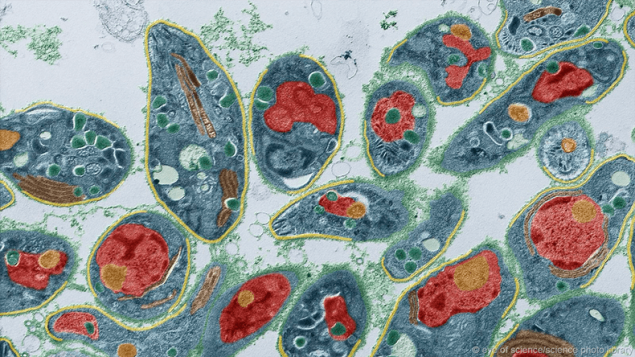
"The vast majority of living on the Earth organisms are composed of cells, and only the viruses have no cellular structure.
This important feature all alive at the present time divided scientists into two areas:
They contain in their composition only one type of nucleic acid, either ribonucleic acid (RNA) or deoxyribonucleic (DNA), and all cellular organisms, including the most primitive bacteria that contain both DNA and RNA simultaneously.
Do not have their own metabolism, have a very limited number of enzymes. For reproduction using the metabolism of the host cell, its enzymes and energy. Viruses, according to Satprem, "use the mind of the cells".
Can exist only as intracellular parasites and do not multiply outside the cells of those organisms which are parasitic.
The most primitive viruses consist of a molecule of RNA (or DNA) surrounded by protein molecules on the outside that wraps a virus. Some viruses have one more external, or secondary, membrane; more complex viruses contain some enzymes.
Nucleic acid is a carrier of the hereditary properties of the virus. Proteins of the inner and outer shells serve to protect it.
Since viruses have no metabolism outside of the cell, they exist as "non-living" particles. In this case we can say that viruses are inert crystals. When hit into the cage they once again come alive.
When breeding to create the components of their particles viruses use nutrients information environment and energy-metabolic system they infected cells. After penetration into the cell, the virus breaks up into its components — nucleic acid and protein shell. From this point biosynthetic processes of the host cell begins to control the genetic information encoded in the nucleic acid of the virus.
In the host cell is a separate synthesis of the shell and the nucleic acid of the virus. Later they unite and form a new virion (fully formed Mature virus).
Viruses do not reproduce on artificial nutrient mediums — they are too choosy in food. They need living cells, and not any, but well-defined.
Science knows viruses of bacteria, plants, insects, animals and humans. All them more than thousand. Associated with the replication of the virus processes often, but not always, damage and destroy the host cell. The reproduction of viruses, combined with the destruction of cells that leads to disease States in the body.
Viruses cause many human diseases: measles, mumps, influenza, polio, rabies, smallpox, yellow fever, trachoma, encephalitis, some kinds of cancer diseases, AIDS, herpes.
Currently, scientists are increasingly suggesting that viruses are the cause of nervous disorders and mental illness. For example, Professor Norbert Nowotny from the University of Vienna has evidence that the Borna virus causing deadly brain disease in animals, but not representing as intended until that time, the danger to humans, able to affect the human brain, causing schizophrenia, depression, and chronic fatigue.
It is known that horses and sheep virus, Borna causes severe cases of inflammation of the brain. As a result of disease, the animals stop eating, lose interest in the environment and in most cases die of paralysis within 3 weeks.
Currently any effective method of treatment of diseased animals does not exist. Recent data suggest that in the human body the virus is still able to cause certain changes in particular, changes in the transmission of nerve signals, leading inevitably to mental disorders.
It is shown that people suffering from neurological disorders, reveals a high level of antibodies to the virus. In addition, the virus is released and many people suffering from chronic fatigue syndrome.
Scientists have found that the human body lives a lot of viruses, but they manifest themselves not always. The pathogenic effects of the virus affected only the weakened body.
The path of infection is very different: through the skin by the bite of insects and ticks; saliva, mucus and other secretions of the patient; through the air; with food; sexually transmitted and other.
There are a number of viruses that are not carriers of diseases. Many of them penetrate the human body, but it does not cause any clinically detectable diseases. They can be long lasting and without any external manifestations to exist in the cells of its host.
Although viruses are not complete living organisms, their evolutionary development has much in common with the evolution of other pathogens. In order to survive as a species, not a single parasite can't be too dangerous for its main host in which to propagate.
Otherwise, this would lead to the complete disappearance of the host species, and with it of the pathogen. At the same time, any pathogenic organism can not exist as a species if his main host too quickly and effectively develops an immunity that can suppress the reproduction of the pathogen.
Instead of pills, squats, push-UPS and exercises for absHow and why to drink water with soda
Therefore, the virus that causes acute and severe disease in any species maintains circulation of the virus in nature. For example, the rabies virus is maintained in nature among rodents, for which infection with this virus is not deadly.
For many viruses, such as measles, herpes, and partly flu, major natural reservoir is man. Transmission of these viruses occurs by airborne droplets or by contact".published
Author: Elena Romanova
Source: romanova-l.livejournal.com/137781.html
The basis for the development of the virus in the human body is energy of a certain quality, of a destructive nature produced them as a result of internal problems with self-esteem, dignity, sense of its existence.

The emergence of viruses in the body signals the person about the lack of joy in life, the collapse of any illusions and the experience of sorrow, of bitterness about it. Such as vibrations (energy) that sets the stage for virus infection, for example, sexually transmitted, can be created in both the current life and to be inherited in the form of genetic programs (stress, vibration), carrying the message of the ancestors of understated meaning of life, by which they were guided, humiliation that they experienced, the loss of the Divine, nedostupnosti, frustration and anguish for the lost.
Transferred program can "sleep" and be activated in a situation when the person will experience profound disappointment, low self-esteem, denial of dignity, loss existing before the meaning of life. The position of the person in these experiences is a certain quality of energy supported the current situation and genetic programs that create better conditions for Contracting the virus.
First is virus infection due to favorable conditions for its life, and then the virus, as the simplest creature wants to live, begins to support these conditions for its existence — the energy-informational background of helplessness, dejection, humiliation of man. It is a vicious circle supported on two sides: man is a thinking and feeling a certain way and virus, and the infected breeding-enabled energy in the body.
The virus integrates into the cell and become part of a person.
To kill the virus, to kill the part of man. Medicine cures the virus preparations and the virus feeds off energy, man.
A person swallows a pill, and think and feel humiliated, confused, pointless, not perstat. The antiviral drug has an effect on anything but thinking.
To kill the virus, it is necessary to heal a person from the causes that creates vibrations favourable to the life of the virus.
If people do not change their attitude towards themselves and the world, will not find meaning, healing his self-esteem, depression, sadness, abandonment, the virus will live and prosper.

At a young age, for example, herpes simplex virus manifests cold on the lips. Man drives away your thoughts and attitudes towards themselves and the world with Hyper-activity (career, family, children, travel, etc.) In the elderly activity in human little, and thought about myself and lived life a lot. Everything tetroxide in distilled, it comes and covers your head, reduces the overall energy of the body.
What can I say, the elderly are not popular in society, and often their relatives and friends do not need, so that the joy of life they do not see. Add to this the separation from the Divine, when a deep-old man not a believer and not experiencing Union with God. Here, where there is carousing lurking virus of the herpes group (herpes, Zoster). This is a very severe form with serious pain.
Medicine does not cure such begins to poison the old body with drugs to numb the virus and to ease the pain. All drugs for the elderly effect on the brain activity (and that stuff didn't but medicine officially scientific explanation, however, the essence is the same), they stanvitsya sluggish, distracted, sleep more, think less, live under medication, like plants.
Forces to change anything in your mind and soul in the elderly often do not. Plus neprimirimost and the habit of defending their worldview (beliefs) the person securely vyrabatyvaetsya since childhood. All of this will not allow you to change the quality of energy (vibration) of the old man. Neither in the soul nor in the mind of man is no God, no faithful representation about the world, the meaning of life. And life is on the wane...
My old mom has herpes started to act cold on the lips, when my father had a stroke. Mother began to be afraid to remain one, the basics of life staggered... Raging case of the herps in full force 2 months after my father's death.
The meaning of life she was lame in both his feet and herpes struck with such force, such pain, what about the care of a close person with whom they had lived for almost 60 years, she was forced to forget. To grieve was no time and forces on the mountain gone, some pain. I had to act, to heal, to find a way to recovery, so the virus retreated.
This is another non-obvious task of a virus to make the cell active. He lives at the expense of its resources, so the cell to survive, it will need to be active or die... Across the cell, the virus pushes the entire body to come to an active state to seek the meaning of life, to move to the spiritual component of life, because the material is already solved — and your career and ambitions and family, and children, and even the necessity of the society.
There is only one Supreme, spiritual, Divine. So, the virus is the messenger of the Supreme. Otherwise, as for worldly Affairs to invite the person to a Higher? Only through disease. Do not pay attention at a young age, in old age all will catch up.
P. S. So, the human always pay attention to its "cold" on the lips: something with the meaning of life is... something handed folks... This is important!

"The vast majority of living on the Earth organisms are composed of cells, and only the viruses have no cellular structure.
This important feature all alive at the present time divided scientists into two areas:
- pre-cellular (viruses and phages),
- cellular (all other organisms: the bacteria and groups close to them, mushrooms, green plants, animals and people).
They contain in their composition only one type of nucleic acid, either ribonucleic acid (RNA) or deoxyribonucleic (DNA), and all cellular organisms, including the most primitive bacteria that contain both DNA and RNA simultaneously.
Do not have their own metabolism, have a very limited number of enzymes. For reproduction using the metabolism of the host cell, its enzymes and energy. Viruses, according to Satprem, "use the mind of the cells".
Can exist only as intracellular parasites and do not multiply outside the cells of those organisms which are parasitic.
The most primitive viruses consist of a molecule of RNA (or DNA) surrounded by protein molecules on the outside that wraps a virus. Some viruses have one more external, or secondary, membrane; more complex viruses contain some enzymes.
Nucleic acid is a carrier of the hereditary properties of the virus. Proteins of the inner and outer shells serve to protect it.
Since viruses have no metabolism outside of the cell, they exist as "non-living" particles. In this case we can say that viruses are inert crystals. When hit into the cage they once again come alive.
When breeding to create the components of their particles viruses use nutrients information environment and energy-metabolic system they infected cells. After penetration into the cell, the virus breaks up into its components — nucleic acid and protein shell. From this point biosynthetic processes of the host cell begins to control the genetic information encoded in the nucleic acid of the virus.
In the host cell is a separate synthesis of the shell and the nucleic acid of the virus. Later they unite and form a new virion (fully formed Mature virus).
Viruses do not reproduce on artificial nutrient mediums — they are too choosy in food. They need living cells, and not any, but well-defined.
Science knows viruses of bacteria, plants, insects, animals and humans. All them more than thousand. Associated with the replication of the virus processes often, but not always, damage and destroy the host cell. The reproduction of viruses, combined with the destruction of cells that leads to disease States in the body.
Viruses cause many human diseases: measles, mumps, influenza, polio, rabies, smallpox, yellow fever, trachoma, encephalitis, some kinds of cancer diseases, AIDS, herpes.
Currently, scientists are increasingly suggesting that viruses are the cause of nervous disorders and mental illness. For example, Professor Norbert Nowotny from the University of Vienna has evidence that the Borna virus causing deadly brain disease in animals, but not representing as intended until that time, the danger to humans, able to affect the human brain, causing schizophrenia, depression, and chronic fatigue.
It is known that horses and sheep virus, Borna causes severe cases of inflammation of the brain. As a result of disease, the animals stop eating, lose interest in the environment and in most cases die of paralysis within 3 weeks.
Currently any effective method of treatment of diseased animals does not exist. Recent data suggest that in the human body the virus is still able to cause certain changes in particular, changes in the transmission of nerve signals, leading inevitably to mental disorders.
It is shown that people suffering from neurological disorders, reveals a high level of antibodies to the virus. In addition, the virus is released and many people suffering from chronic fatigue syndrome.
Scientists have found that the human body lives a lot of viruses, but they manifest themselves not always. The pathogenic effects of the virus affected only the weakened body.
The path of infection is very different: through the skin by the bite of insects and ticks; saliva, mucus and other secretions of the patient; through the air; with food; sexually transmitted and other.
There are a number of viruses that are not carriers of diseases. Many of them penetrate the human body, but it does not cause any clinically detectable diseases. They can be long lasting and without any external manifestations to exist in the cells of its host.
Although viruses are not complete living organisms, their evolutionary development has much in common with the evolution of other pathogens. In order to survive as a species, not a single parasite can't be too dangerous for its main host in which to propagate.
Otherwise, this would lead to the complete disappearance of the host species, and with it of the pathogen. At the same time, any pathogenic organism can not exist as a species if his main host too quickly and effectively develops an immunity that can suppress the reproduction of the pathogen.
Instead of pills, squats, push-UPS and exercises for absHow and why to drink water with soda
Therefore, the virus that causes acute and severe disease in any species maintains circulation of the virus in nature. For example, the rabies virus is maintained in nature among rodents, for which infection with this virus is not deadly.
For many viruses, such as measles, herpes, and partly flu, major natural reservoir is man. Transmission of these viruses occurs by airborne droplets or by contact".published
Author: Elena Romanova
Source: romanova-l.livejournal.com/137781.html
The Alfred Laengle: Often we don't even realize that every minute you want something
"Quantum" electric car nanoFlowcell will launch a series of
